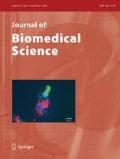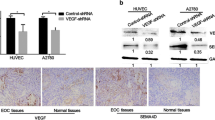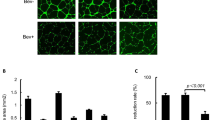Abstract
Vascular endothelial growth factor C (VEGF-C) is an important growth factor that governs lymphatic spread and the development of intraperitoneal tumors associated with epithelial ovarian cancer; however, its regulation is not yet understood. Overexpression of Her-2/neu is related to poor survival in advanced epithelial ovarian carcinoma patients. Accordingly, this study attempted to analyze the association between the Her-2/neu oncogene and VEGF-C in ovarian carcinoma and to elucidate the molecular mechanism of VEGF-C induction by Her-2/neu. Immunohistochemistry was used to determine the expression of Her-2/neu and VEGF-C in tissues from 41 patients with epithelial ovarian carcinoma. Several Her-2/neu-stably-transfected Caov-3 ovarian carcinoma cells were used to evaluate the effect of Her-2/neu on VEGF-C, the possible regulation mechanism, and the biological function of VEGF-C. Our experimental results identified a significant association between the Her-2/neu oncogene and VEGF-C expression in both epithelial ovarian cancer patients (p < 0.05; Fisher's exact test) and in vitro cell lines. The overexpression of Her-2/neu in Caov-3 ovarian cancer cells resulted in induction of a considerable amount of VEGF-C mRNA and protein; this process was dose-dependently inhibited by herceptin. The generation of VEGF-C significantly increased endothelial permeability. Pharmacological and genetic inhibition assays revealed that the cytoplasmic signaling molecule, p38 MAPK, and the transcriptional factor, NF-κB, are critically involved in the transcriptional activation of the VEGF-C gene by Her-2/neu. In conclusion, this work clearly establishes that the Her-2/neu oncogene is essential for the regulation of VEGF-C in ovarian carcinoma. It may be possible to use the monoclonal antibody targeting Her-2/neu receptor to limit the formation of malignant ascites and lymphatic spread in ovarian carcinoma.
Similar content being viewed by others
References
Berchuck A, Kamel A, Whitaker R, Kerns B, Olt G, Kinney R, Soper JT, Dodge R, Clarke-Pearson DL, Marks P. Overexpression of HER-2/neu is associated with poor survival in advanced epithelial ovarian cancer. Cancer Res 50:4087–4091;1990.
Chilov D, Kukk E, Taira S, Jeltsch M, Kaukonen J, Palotie A, Joukov V, Alitalo K. Genomic organization of human and mouse genes for vascular endothelial growth factor C. J Biol Chem 272:25176–25183;1997.
Dias S, Choy M, Alitalo K, Rafii S. Vascular endothelial growth factor (VEGF)-C signaling through FLT-4 (VEGFR-3) mediates leukemic cell proliferation, survival, and resistance to chemotherapy. Blood 99:2179–2184;2002.
Felip E, Del Campo JM, Rubio D, Vidal MT, Colomer R, Bermejo B. Overexpression of cerbB-2 in epithelial ovarian cancer. Prognostic value and relationship with response to chemotherapy. Cancer 75:2147–2152;1995.
Hashimoto I, Kodama J, Seki N, Hongo A, Yoshinouchi M, Okuda H, Kudo T. Vascular endothelial growth factor-C expression and its relationship to pelvic lymph node status in invasive cervical cancer. Br J Cancer 85:93–97;2001.
Hasumi Y, Mizukami H, Urabe M, Kohno T, Takeuchi K, Kume A, Momoeda M, Yoshikawa H, Tsuruo T, Shibuya M. Soluble FLT-1 expression suppresses carcinomatous ascites in nude mice bearing ovarian cancer. Cancer Res 62:2019–2023;2002.
Hellstrom I, Goodman G, Pullman J, Yang Y, Hellstrom KE. Overexpression of HER-2 in ovarian carcinomas. Cancer Res 61:2420–2423;2001.
Holschneider CH, Berek JS. Ovarian cancer: Epidemiology, biology, and prognostic factors. Semin Surg Oncol 19:3–10;2000.
Huang M, Page C, Reynolds RK, Lin J. Constitutive activation of stat 3 oncogene product in human ovarian carcinoma cells. Gynecol Oncol 79:67–73;2000.
Hung MC, Lau YK. Basic science of HER-2/neu: A review. Semin Oncol 26:51–59;1999.
Joukov V, Kumar V, Sorsa T, Arighi E, Weich H, Saksela O, Alitalo K. A recombinant mutant vascular endothelial growth factor-C that has lost vascular endothelial growth factor receptor-2 binding, activation, and vascular permeability activities. J Biol Chem 273:6599–6602;1998.
Joukov V, Pajusola K, Kaipainen A, Chilov D, Lahtinen I, Kukk E, Saksela O, Kalkkinen N, Alitalo K. A novel vascular endothelial growth factor, VEGF-C, is a ligand for the Flt4 (VEGFR-3) and KDR (VEGFR-2) receptor tyrosine kinases. EMBO J 15:1751;1996.
Kajita T, Ohta Y, Kimura K, Tamura M, Tanaka Y, Tsunezuka Y, Oda M, Sasaki T, Watanabe G. The expression of vascular endothelial growth factor C and its receptors in non-small cell lung cancer. Br J Cancer 85:255–260;2001.
Karpanen T, Egeblad M, Karkkainen MJ, Kubo H, Yla-Herttuala S, Jaattela M, Alitalo K. Vascular endothelial growth factor C promotes tumor lymphangiogenesis and intralymphatic tumor growth. Cancer Res 61:1786–1790;2001.
Kawakami M, Furuhata T, Kimura Y, Yamaguchi K, Hata F, Sasaki K, Hirata K. Quantification of vascular endothelial growth factor-C and its receptor-3 messenger RNA with real-time quantitative polymerase chain reaction as a predictor of lymph node metastasis in human colorectal cancer. Surgery 133:300–308;2003.
Kim RY, Omura GA, Alvarez RD. Advances in the treatment of gynecologic malignancies. 2. Cancers of the uterine corpus and ovary. Oncology (Huntingt) 16:1669–1678; discussion 1678–1680;2002.
Laughner E, Taghavi P, Chiles K, Mahon PC, Semenza GL. HER2 (neu) signaling increases the rate of hypoxia-inducible factor lalpha (HIF-1alpha) synthesis: Novel mechanism for HIF-1-mediated vascular endothelial growth factor expression. Mol Cell Biol 21:3995–4004;2001.
Madrid LV, Mayo MW, Reuther JY, Baldwin AS Jr. Akt stimulates the transactivation potential of the RelA/p65 Subunit of NF-kappa B through utilization of the Ikappa B kinase and activation of the mitogen-activated protein kinase p38. J Biol Chem 276:18934–18940;2001.
Makinen T, Jussila L, Veikkola T, Karpanen T, Kettunen MI, Pulkkanen KJ, Kauppinen R, Jackson DG, Kubo H, Nishikawa S. Inhibition of lymphangiogenesis with resulting lymphedema in transgenic mice expressing soluble VEGF receptor-3. Nat Med 7:199–205;2001.
Mazin AV, Saparbaev MK, Ovchinnikova LP, Dianov GL, Salganik RI. Site-directed insertion of long single-stranded DNA fragments into plasmid DNA. DNA Cell Biol 9:63–69;2001.
Meden H, Marx D, Roegglen T, Schauer A, Kuhn W. Overexpression of the oncogene c-erbB-2 (HER2/neu) and response to chemotherapy in patients with ovarian cancer. Int J Gynecol Pathol 17:61–65;1998.
Mesiano S, Ferrara N, Jaffe RB. Role of vascular endothelial growth factor in ovarian cancer: Inhibition of ascites formation by immunoneutralization. Am J Pathol 153:1249–1256;1998.
Mills GB, May C, Hill M, Campbell S, Shaw P, Marks A. Ascitic fluid from human ovarian cancer patients contains growth factors necessary for intraperitoneal growth of human ovarian adenocarcinoma cells. J Clin Invest 86:851–855;1990.
Niki T, Iba S, Tokunou M, Yamada T, Matsuno Y, Hirohashi S. Expression of vascular endothelial growth factors A, B, C, and D and their relationships to lymph node status in lung adenocarcinoma. Clin Cancer Res 6:2431–2439;2000.
O-charoenrat P, Rhys-Evans PH, Archer DJ, Eccles SA. C-erbB receptors in squamous cell carcinomas of the head and neck: Clinical significance and correlation with matrix metallo-proteinases and vascular endothelial growth factors. Oral Oncol 38:73–80;2002.
Orsulic S, Li Y, Soslow RA, Vitale-Cross LA, Gutkind JS, Varmus HE. Induction of ovarian cancer by defined multiple genetic changes in a mouse model system. Cancer Cell 1:53–62;2002.
Pianetti S, Arsura M, Romieu-Mourez R, Coffey RJ, Sonenshein GE. Her-2/neu overexpression induces NF-kappaB via a PI3-kinase/Akt pathway involving calpain-mediated degradation of IkappaB-alpha that can be inhibited by the tumor suppressor PTEN. Oncogene 20:1287–1299;2001.
Ristimaki A, Narko K, Enholm B, Joukov V, Alitalo K. Proinflammatory cytokines regulate expression of the lymphatic endothelial mitogen vascular endothelial growth factor-C. J Biol Chem 273:8413–8418;1998.
Romano MF, Lamberti A, Bisogni R, Tassone P, Pagnini D, Storti G, Del Vecchio L, Turco MC, Venuta S. Enhancement of cytosine arabinoside-induced apoptosis in human myeloblastic leukemia cells by NF-kappa B/Rel-specific decoy oligodeoxynucleotides. Gene Ther 7:1234–1237;2000.
Rubin SC, Finstad CL, Wong GY, Almadrones L, Plante M, Lloyd KO. Prognostic significance of HER-2/neu expression in advanced epithelial ovarian cancer: A multivariate analysis. Am J Obstet Gynecol 168:162–169;1993.
Schlessinger J. Ligand-induced, receptor-mediated dimerization and activation of EGF receptor. Cell 110:669–672;2002.
Shayesteh L, Lu Y, Kuo WL, Baldocchi R, Godfrey T, Collins C, Pinkel D, Powell B, Mills GB, Gray JW. PIK3CA is implicated as an oncogene in ovarian cancer. Nat Genet 21:99–102;1999.
Slamon DJ, Godolphin W, Jones LA, Holt JA, Wong SG, Keith DE, Levin WJ, Stuart SG, Udove J, Ullrich A. Studies of the HER-2/neu proto-oncogene in human breast and ovarian cancer. Science 244:707–712;1989.
Tsai PW, Shiah SG, Lin MT, Wu CW, Kuo ML. Up-regulation of vascular endothelial growth factor C in breast cancer cells by heregulin-beta 1. A critical role of p38/nuclear factor-kappa B signaling pathway. J Biol Chem 278:5750–5759;2003.
Veikkola T, Jussila L, Makinen T, Karpanen T, Jeltsch M, Petrova TV, Kubo H, Thurston G, McDonald DM, Achen MG. Signalling via vascular endothelial growth factor receptor-3 is sufficient for lymphangiogenesis in transgenic mice. EMBO J 20:1223–1231;2001.
Xu Y, Gaudette DC, Boynton JD, Frankel A, Fang XJ, Sharma A, Hurteau J, Casey G, Goodbody A, Mellors A. Characterization of an ovarian cancer activating factor in ascites from ovarian cancer patients. Clin Cancer Res 1:223–234;1995.
Yang W, Klos K, Yang Y, Smith TL, Shi D, Yu D. ErbB2 overexpression correlates with increased expression of vascular endothelial growth factors A, C, and D in human breast carcinoma. Cancer 94:2855–2861;2002.
Yokoyama Y, Charnock-Jones DS, Licence D, Yanaihara A, Hastings JM, Holland CM, Emoto M, Umemoto M, Sakamoto T, Sato S. Vascular endothelial growth factor-D is an independent prognostic factor in epithelial ovarian carcinoma. Br J Cancer 88:237–244;2003.
Yokoyama Y, Sakamoto T, Sato S, Saito Y. Evaluation of cytoreductive surgery with pelvic and paraaortic lymphadenectomy and intermittent cisplatin-based combination chemotherapy for improvement of long-term survival in ovarian cancer. Eur J Gynaecol Oncol 20:361–366;1999.
Zhou BP, Hu MC, Miller SA, Yu Z, Xia W, Lin SY, Hung MC. HER-2/neu blocks tumor necrosis factor-induced apoptosis via the Akt/NF-kappaB pathway. J Biol Chem 275:8027–8031;2000.
Author information
Authors and Affiliations
Rights and permissions
About this article
Cite this article
Hsieh, CY., Chen, CA., Chou, CH. et al. Overexpression of Her-2/neu in epithelial ovarian carcinoma induces vascular endothelial growth factor C by activating NF-κB: Implications for malignant ascites formation and tumor lymphangiogenesis. J Biomed Sci 11, 249–259 (2004). https://doi.org/10.1007/BF02256568
Received:
Accepted:
Issue Date:
DOI: https://doi.org/10.1007/BF02256568




